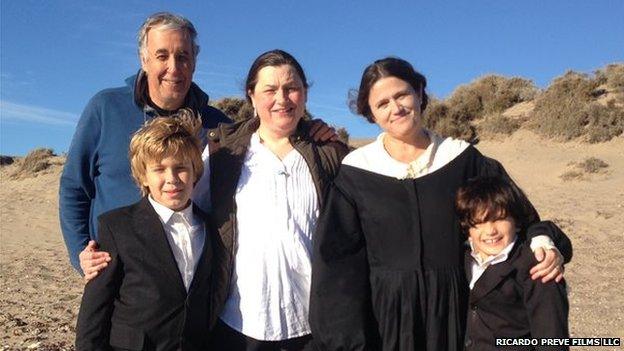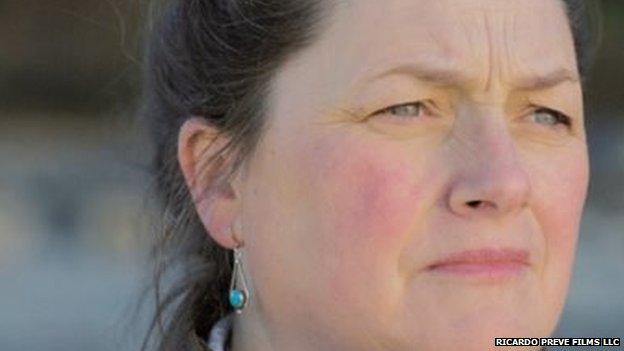DNA solves 20-year-old Patagonia bones mystery
- Published

Nia Olwen Ritchie and Ricardo Preve on set with the actors who are part of a documentary about her story
More than 150 years after the first Welsh settlers landed in Argentina, a woman from Conwy county has helped end the mystery of one of the first arrivals in Patagonia.
In 1995, construction workers in Puerto Madryn unearthed human remains.
Physiological evidence as well as artefacts found nearby suggested they were those of Catherine Roberts, who arrived in Argentina aboard the Mimosa on 28 July 1865 along with 152 other Welsh people looking for a new life.
But a positive DNA identification only became possible this year after researchers traced her descendants to Nia Olwen Ritchie in Cerrigydrudion.
Now, firefighter Nia's 12,000-mile (19,300km) journey to discover her ancestor is to be shown in a documentary for Argentinian television.
Ricardo Preve, producer of The Patagonian Bones, said: "The mystery of Catherine Roberts's bones was a detective story that needed solving and it has captivated me for some time now.
"Finding Nia was essential to confirming the DNA connection but we did not bank on the help she was able to give us on the ground in Wales and her wonderful enthusiasm in helping to tell this intriguing story."
Catherine Roberts was 36 in 1865 when she paid the princely sum of £12 for her journey from Liverpool to Patagonia.

The only known photograph of Catherine was taken just before she left Wales
The ageing clipper Mimosa had not been designed to carry passengers and the voyage took two months.
Conditions upon arrival were little better and apart from a small advance party, the region of the Chubut Valley where they landed was completely uncolonised.
Chronicles of the earliest Welsh settlers detail how Catherine was the first of the newcomers to die on Patagonian soil, although they do not mention exactly where she was buried.
Suspicions were first raised that the skeleton discovered in 1995 may have been hers when a ring and button discovered in the grave were found to have been of Welsh origin.
The chronicles also describe how the earliest Welsh coffins were constructed from pine salvaged from a shipwreck - fragments of the same Scotch Pine were found in Catherine's grave.
Examinations of the bones found they were of the correct age and size, and also revealed a distinctive abnormality of the jaw bone which can be seen in the only known photograph of Catherine, taken shortly before she set sail.
Despite world-renowned forensic anthropologist Dr Carlos Vullo managing to sequence female DNA from the skeleton, the trail went cold because none of Catherine's female descendants could be traced.
Eventually a 10-year "woman hunt" led Ricardo Preve and Dr Vullo to Nia.

Nia visited Argentina so her DNA could be taken and matched against the bones
"I was amazed to be contacted in this way but fascinated by the story of my ancestor and really wanted to help where I could," Nia said.
"Before I flew to Argentina in April for the DNA testing I welcomed Ricardo Preve to north Wales and during March I showed him various locations for his documentary, including the ruins of Catherine's home in Llandrillo and the chapel where her mother is buried.
"At that stage we did not know if the bones belonged to Catherine but all the early signs looked positive.
"I was absolutely thrilled when they were confirmed.
"It is a fitting end to her story and wonderful to know that she can be properly laid to rest now and not end her days in a research lab."
From those first 153 settlers, today it is thought there are about 50,000 people with Welsh heritage in Patagonia - about 5,000 of those are Welsh-speakers.
Mr Preve is now hoping to sign an agreement with UK broadcasters so English and Welsh versions of the documentary can be shown in time for the 150th anniversary of the migration in July.
- Published19 April 2015

- Published16 October 2014
